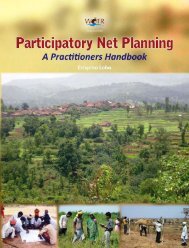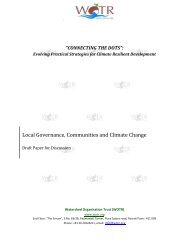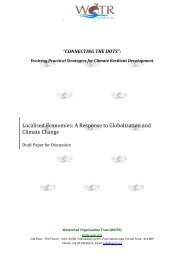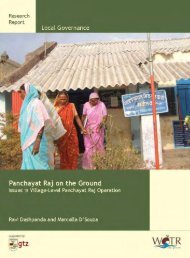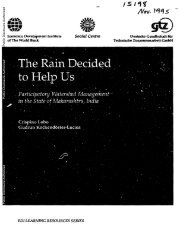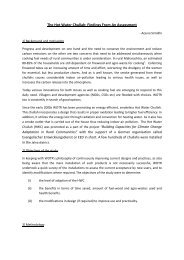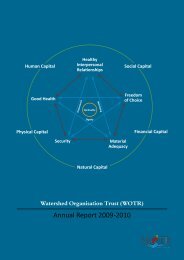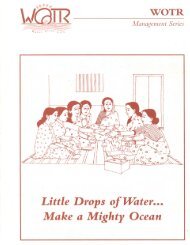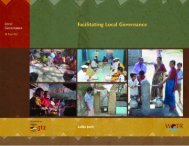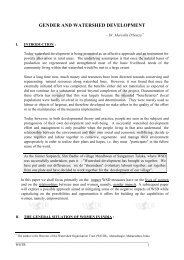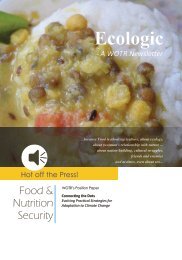Facilitating Change – Creating Institutional and Policy Spaces ... - wotr
Facilitating Change – Creating Institutional and Policy Spaces ... - wotr
Facilitating Change – Creating Institutional and Policy Spaces ... - wotr
You also want an ePaper? Increase the reach of your titles
YUMPU automatically turns print PDFs into web optimized ePapers that Google loves.
<strong>Facilitating</strong> <strong>Change</strong> <strong>–</strong> <strong>Creating</strong> <strong>Institutional</strong> <strong>and</strong> <strong>Policy</strong> <strong>Spaces</strong>: A Case<br />
Study of the Indo-German Watershed Development Programme<br />
(IGWDP)<br />
Background:<br />
Watershed Organisation Trust (WOTR)<br />
Crispino Lobo<br />
The Indo-German Watershed Development Programme (IGWDP) which was initiated in<br />
1989 (operationalised in 1992) by Fr. Herman Bacher is now in its 15th year of existence<br />
in Maharashtra. What began amidst great difficulties <strong>and</strong> uncertainties has now spread to<br />
2 other states in India (Andhra Pradesh <strong>and</strong> Gujarat), developed innovative approaches<br />
<strong>and</strong> methodologies, secured important policy changes, influenced major watershed<br />
programmes in the country <strong>and</strong> has been the raison d'etre as well as the template of the<br />
National Watershed Development Fund (NWDF) which seeks to replicate the effort in 100<br />
poor districts of the country. It has been widely studied <strong>and</strong> referred to as a prime example<br />
of successful public-private-civil society partnership involving multi-sectoral interventions<br />
<strong>and</strong> extending from the local to the regional, national <strong>and</strong> international levels.<br />
The key to its success has been its developmental philosophy, a robust partnership<br />
amongst its key actors, an enabling policy environment, firm political <strong>and</strong> governmental<br />
support on both the Indian <strong>and</strong> German side, an innovative <strong>and</strong> path breaking capacity<br />
building pedagogy, unique institutional arrangements <strong>and</strong> secure funding.<br />
In this paper, we shall touch upon the policy <strong>and</strong> institutional aspects that contributed to<br />
making the Program a success.<br />
1
History:<br />
The IGWDP arose out of a confluence of several events <strong>and</strong> processes.<br />
In Germany, during the 1980's, German developmental cooperation policy came under<br />
review as it was realized that, with very few exceptions, official aid reached the poor<br />
largely by way of exception. It was decided to launch a worldwide study to assess <strong>and</strong><br />
determine the conditions under which official aid could directly reach the poor in a manner<br />
that empowered them to free themselves from poverty. In India, on the other h<strong>and</strong>, there<br />
was also a growing realization that despite huge amounts spent on poverty alleviation<br />
programmes, the absolute <strong>and</strong> relative number of people living in poverty remained<br />
stubbornly constant. Both sides realized that despite their best efforts, something critically<br />
was missing <strong>and</strong> had to be addressed if a difference was to be made.<br />
These two processes resulted in the launching in India of the Indo German Pilot Program<br />
(IGPP) in which both Governmental <strong>and</strong> Non-Governmental developmental agencies<br />
involved in policy making, funding, implementation <strong>and</strong> research on the German (BMZ,<br />
KfW, GTZ, Misereor, EZE, DSE (Now InWent), etc.) <strong>and</strong> Indian (MOF/DEA, MOA,<br />
NABARD, IGSS, IIM, GIAP, NGOs, etc) sides participated.<br />
Some of the key learnings that emerged from this process of research, dialogue <strong>and</strong><br />
engagement were:<br />
- Any developmental initiative will be successful only if it is “owned” by the target<br />
group itself. People had to consider themselves not as beneficiaries, but as active<br />
agents of their own developments (“Artisans of their own Destiny”)<br />
- They, therefore, had to be involved at all stages in a developmental intervention,<br />
from its design through implementation to maintenance. They had to be a part of<br />
the entire project cycle where responsibilities are matched with authority, access to<br />
resources with accountability, at every level.<br />
- The role of every agency (besides that of the target group) would have to be that of<br />
a facilitator <strong>and</strong> accompanier, not as “doer” on behalf of the target group or<br />
substitute for their own efforts.<br />
Watershed Organisation Trust (WOTR)<br />
2
- Given the multi-dimensionality of poverty, various developmental actors including<br />
those of the policy <strong>and</strong> institutional framework, would have to be engaged if<br />
sustainable impacts <strong>and</strong> outcomes were to be achieved. Effective <strong>and</strong> synergistic<br />
partnerships would have to be entered into across the three sectors <strong>–</strong> civil society,<br />
public <strong>and</strong> private.<br />
- If success were to spread, “facilitating involvement” (as opposed to control) by<br />
framework actors, namely, govt. <strong>and</strong> political institutions would have to be ensured<br />
at all stages of interventions.<br />
- Since the environment provides the basis of survival in rural areas, especially for<br />
the poor, regenerating it in a participatory, equitable <strong>and</strong> sustainable manner along<br />
watershed lines would offer a promising approach to mobilize communities for<br />
poverty reduction.<br />
Fr. Herman Bacher, who has been involved in the developmental sector for over 50 years<br />
<strong>and</strong> who was involved in the entire IGPP study, saw the opportunity that arose from the<br />
confluence of these various events <strong>and</strong> processes <strong>and</strong> conceived of a large scale<br />
community-driven program for poverty reduction, centered on regenerating the<br />
environmental space of villagers along watershed lines. The people themselves would be<br />
responsible for the project, with NGOs facilitating them <strong>and</strong> all other actors playing the role<br />
of enablers.<br />
Given Fr. Bacher’s credibility <strong>and</strong> experience, he was successful in convincing both the<br />
Indian <strong>and</strong> German Governments to accept, approve <strong>and</strong> fund the project. The first official<br />
agreement was signed in 1989. 1 However it took some time for formalities to be completed<br />
<strong>and</strong> procedures to be set in place <strong>and</strong> the IGWDP became fully operational only beginning<br />
1993.<br />
1 The author of this article, Crispino Lobo, joined Fr. Bacher in May 1989 <strong>and</strong> together with him developed the<br />
institutional <strong>and</strong> organizational framework of the IGWDP. He was the Programme Coordinator from 1989 up to March<br />
2001, after which, the post ceased to exist.<br />
Watershed Organisation Trust (WOTR)<br />
3
From Concept to Practice: Challenges, Creativity <strong>and</strong> Innovation<br />
1. Securing Agreements <strong>–</strong> A Confluence of Interest:<br />
The German side agreed to fund it under official development assistance (ODA) as it<br />
met all their criteria for grant-based funding, namely, environmental regeneration, self-<br />
help, poverty reduction <strong>and</strong> women’s involvement. In June 1988, the Parliamentary<br />
Commission for Economic Cooperation, following a Public Hearing, passed a<br />
resolution titled “Fighting Poverty through Self Help” calling upon the German Govt. to<br />
re-orient its official development aid towards poverty alleviation in a way that placed<br />
the poor at the center of the developmental intervention. Subsequently, the German<br />
Parliament passed a resolution supported by all parties (remarkable, indeed!)<br />
m<strong>and</strong>ating the Govt. to increase <strong>and</strong> re-orient its Overseas Development Assistance<br />
(ODA) for poverty reduction through Self Help efforts which if, henceforth, would be<br />
grant financed. The project proposed by Fr. Bacher (namely, the IGWDP) fitted in<br />
nicely with the new institutional <strong>and</strong> developmental thrust in Germany <strong>and</strong> offered an<br />
opportunity to realize these new orientations <strong>and</strong> perspectives on a large-scale.<br />
The Indian side approved it because participatory watershed development had come<br />
to be seen as crucial to stabilizing dryl<strong>and</strong> <strong>and</strong> rainfed farming systems (<strong>and</strong><br />
consequently enhancing agricultural income), which cover over 70% of India's arable<br />
l<strong>and</strong>s. Further more, the success of the voluntary sector in reaching the poor, albeit on<br />
a very limited scale, was by then widely recognized. Officially also, there was a<br />
growing acceptance of the voluntary sector as a necessary <strong>and</strong> important partner in<br />
the national development effort for poverty alleviation. It was also realized that people<br />
had to be in the “driver’s seat”, having access to resources <strong>and</strong> being publicly<br />
accountable, if sustainable improvements in welfare <strong>and</strong> quality of life were to be<br />
achieved.<br />
2. Getting in the Funds:<br />
These being bilateral funds, they normally would have to be routed through either the<br />
Central or State Govt. treasuries. However, the procedural <strong>and</strong> other complexities<br />
Watershed Organisation Trust (WOTR)<br />
4
involved in accessing budgetary resources, <strong>and</strong> the need to have funds allocated in a<br />
flexible manner <strong>and</strong> available on a timely basis, made the NGOs as well as the target<br />
groups (villagers) uncomfortable with this route. On the other h<strong>and</strong>, if the funds were<br />
routed outside the budgetary channel, they would then attract the provisions of the<br />
Foreign Contribution Act (FCRA). Since the goal of the IGWDP was to create a large-<br />
scale movement involving civil society, most of the NGOs, especially the smaller ones,<br />
<strong>and</strong> all the Community Based Organisations (CBO’s) would have been excluded from<br />
directly receiving these funds. Moreover, whatever channel was used, since these<br />
funds were ODA <strong>and</strong> fairly substantial, both the Govt. of Germany <strong>and</strong> Govt. of India<br />
would have to be assured of its deployment <strong>and</strong> proper utilization.<br />
Since NABARD had been involved in the IGPP, <strong>and</strong> Fr. Bacher personally knew its top<br />
management, he decided to explore NABARD as the routing agency for the German<br />
Funds (KfW). 2<br />
NABARD, being a Govt. institution, would meet the requirement of governmental<br />
oversight, (both from the German <strong>and</strong> Indian sides), could accept the funds directly (do<br />
away with the budgetary route) <strong>and</strong> would not attract the provisions of the FCRA.<br />
Being a public sector financial institution dealing with large amounts of money <strong>and</strong><br />
having experience in dealing with bilateral <strong>and</strong> multi-lateral funding institutions, it would<br />
also provide a credible counter part to the official German Funding Agencies.<br />
However, NABARD, being a credit disbursing agency, faced an initial difficulty in<br />
administrating these funds since they were grants <strong>and</strong> had to be disbursed as grants.<br />
However, there is a provision in the NABARD Act, which allowed for NABARD to<br />
accept <strong>and</strong> disburse grants for action research purposes <strong>and</strong> innovative pilot projects<br />
especially those which would test out approaches <strong>and</strong> mechanisms that enhance<br />
credit absorption <strong>and</strong> utilization. Since NABARD largely re-finances agricultural<br />
operations, a good amount of which is rain dependent, promoting watershed<br />
development as a means of stabilizing <strong>and</strong> productivising rural agricultural credit was<br />
2 At the time, there was no Capacity Building Phase <strong>and</strong> ODA for the IGWDP was by way of Financial Cooperation.<br />
The German Govt routed this through the German Bank for Development (KfW). Later, in 1992, when the Capacity<br />
Building Phase was established, the German Govt. routed a part of ODA by way of Technical Cooperation through the<br />
German Agency For Technical Cooperation (GTZ) directly to WOTR, which was given an official role in the bilateral<br />
arrangements pertaining to the IGWDP.<br />
Watershed Organisation Trust (WOTR)<br />
5
viewed as innovative, in line with its m<strong>and</strong>ate, <strong>and</strong> therefore qualified to be taken up on<br />
a pilot basis.<br />
A difficulty arose in routing these funds to the villagers directly. Since, at the village<br />
level, the legal project holder was the Village Watershed Committee (VWC)<br />
consensually nominated by the Gram Sabha 3 <strong>and</strong> since this was not a registered body,<br />
the question of whether they could receive funds from a public sector institution <strong>and</strong> be<br />
held accountable for the same arose. 4 Local Banks refused to open accounts in the<br />
name of the VWC.<br />
The Bombay Village Panchayat Act of 1958 provided a legal solution. It held that when<br />
the majority of adult voting members in a village held a Gram Sabha in accordance<br />
with the provisions of the Act <strong>and</strong> passed a Resolution, that Resolution was a formal<br />
act, having a legal basis, was binding <strong>and</strong> enforceable. Thus the VWC that is<br />
established in such a manner becomes a formal body, a person in law <strong>and</strong> therefore,<br />
eligible to receive funds <strong>and</strong> be held accountable for them. When this was brought to<br />
their attention, local banks began to open accounts in the name of the VWCs <strong>and</strong><br />
funds were disbursed directly to these accounts.<br />
3. Expansion: Introduction of Capacity Building as a Pre-condition to<br />
Full Implementation<br />
When the IGWDP began, there were only 7 NGOs were involved, of whom only two<br />
had some experience in integrated watershed development. If the Programme was to<br />
become a movement, as envisaged, <strong>and</strong> go to scale rapidly, a lot many more NGOs<br />
would have to be involved, common st<strong>and</strong>ards <strong>and</strong> protocols developed <strong>and</strong> best<br />
practices put in place. This called for a substantial expansion in existing capacities,<br />
identification of new NGO partners <strong>and</strong> the development of a pedagogy that<br />
systematically built up the institutional, organisational <strong>and</strong> operational capacities of<br />
NGOs as well as the VWCs <strong>and</strong> other CBOs. Existing resource agencies were unable<br />
to meet this requirement <strong>and</strong> by 1993, the IGWDP was floundering <strong>and</strong> not making<br />
much headway.<br />
3 Gram Sabha is the body of all voting adults living within the boundaries of a revenue/ natural village.<br />
4 The question was: who is the legal recipient of the funds? Is it a “person” in law, who can be sued <strong>and</strong> be held<br />
responsible for repayment in case of mis-utilization?<br />
Watershed Organisation Trust (WOTR)<br />
6
It was decided by a group of prominent NGO leaders to set up a new organisation to<br />
cater to the capacity building needs of the IGWDP as well as to provide an institutional<br />
base for the Programme Coordinator 5 .<br />
Thus, the Watershed Organisation Trust (WOTR) was established in December 1993<br />
as an NGO under the Bombay Public Trust Act 1950.<br />
Since then, the Programme has grown from 7 NGOs to 75, from 16,000 hectares to<br />
over 165,000 ha at present, representing an annual growth rate of 81% <strong>and</strong> 78%<br />
respectively. The key to this rapid expansion was the development by WOTR of a<br />
st<strong>and</strong> alone rigorous Capacity Building Phase (CBP) as a pre-condition to undertaking<br />
full implementation of a watershed development project. It was m<strong>and</strong>atory that all<br />
intending NGOs <strong>and</strong> village groups/ CBOs go through this process over a period of 12-<br />
18 months. No project would be accepted by NABARD for full implementation unless it<br />
successfully went through the Capacity Building Phase. The salient components of this<br />
Capacity Building Phase was a pedagogy called the Participatory Operational<br />
Pedagogy (POP) 6 , the Gender Oriented POP (GO-POP) 7 , the Participatory Net<br />
Planning Methodology (PNP) 8 , Participatory Impact Monitoring (PIM) 9 <strong>and</strong> various IT<br />
based systems for project formulation, record keeping <strong>and</strong> reporting.<br />
At the time of the launch of the IGWDP, there was no Capacity Building Phase as the<br />
KfW, which was the initial funding agency, could only provide funds for Financial<br />
Cooperation (investment purposes) at the time. Capacity Building was considered<br />
Technical Cooperation, which came under the purview of the German Agency for<br />
Technical Cooperation (GTZ). The German Govt. agreed to support the CBP as<br />
Technical Cooperation <strong>and</strong> routed the funds through the GTZ to WOTR. The Indian<br />
Govt. accorded its approval <strong>and</strong> these funds, being part of ODA, were exempted from<br />
5<br />
Please refer below to Section 4, point no. 3: “<strong>Institutional</strong> <strong>and</strong> Organisational Arrangements-Making Things Happen”<br />
for details on the Office of the Program Coordinator.<br />
6<br />
The POP is a systematic step-by-step approach to building up the capacities of NGOs <strong>and</strong> Village Self Help Groups<br />
(VSHGs) to undertake watershed development. The POP has been recognized as a significant tool for up scaling <strong>and</strong><br />
managing large-scale programmes.<br />
7<br />
Gender <strong>and</strong> women’s promotion has been specifically interwoven into every component of the POP. This genderinclusive<br />
POP is called the GO-POP.<br />
8<br />
PNP is a site-specific <strong>and</strong> farmer friendly method of planning for watershed development. Each l<strong>and</strong> holding is visited<br />
<strong>and</strong> surveyed by the planning team along with the farmer couple <strong>and</strong> measures decided upon as required. This builds a<br />
sense of ownership in the farmer couple for the proposed measures <strong>and</strong> also enables realistic planning.<br />
9<br />
PIM involves the villagers in identifying indicators that measure <strong>and</strong> assess impacts of the watershed measures<br />
undertaken. Once these indicators are participatorily identified, the community, facilitated by the accompanying NGO,<br />
then collects information <strong>and</strong> tracks changes at various times during project implementation. This helps the community<br />
internalize lessons learnt <strong>and</strong> also deepens their underst<strong>and</strong>ing of what really is happening to them <strong>and</strong> their village.<br />
Watershed Organisation Trust (WOTR)<br />
7
the purview of the FCRA. Thus, WOTR was granted the status of an official partner<br />
within this bilateral development cooperation. These funds were available for direct<br />
disbursement to NGOs (even those that didn’t have FCRA registration) <strong>and</strong> village<br />
groups.<br />
4. <strong>Institutional</strong> <strong>and</strong> Organisational Arrangements: Making Things<br />
Happen.<br />
While everybody agrees that participation of the target group is vital to the success of<br />
any developmental venture, not enough attention is paid to devising institutional,<br />
administrative, managerial <strong>and</strong> financial arrangements that foster <strong>and</strong> support<br />
“ownership” <strong>and</strong> whole hearted involvement of the target group. Such neglect often<br />
leads to a situation that can be described as “institutional schizophrenia”, where, what<br />
is sought to be achieved (in this case, participation <strong>and</strong> stakeholdership) by a<br />
particular instrument or arrangement, is not possible, as it is not configured towards<br />
delivering or arriving at that output.<br />
This arises due to asymmetries (power, information, organisational capabilities,<br />
resources, etc.) between the actors, as is often in the case of projects funded/<br />
managed by major actors like government or large donors. An institution given to a “top<br />
down” <strong>and</strong> bureaucratized culture cannot possibly promote <strong>and</strong> support genuine<br />
participation (even with the best of intentions) unless it also opens itself to the “other<br />
view”- in this case, civil society actors’- <strong>and</strong> enters into an enabling partnership with the<br />
other 10 . This is quite the opposite of a controlling, dependency-engendering,<br />
contractor-contractee or vendor-client relationship. These kinds of relationships only<br />
instrumentalise <strong>and</strong> co-opt civil society actors <strong>and</strong> cannot be treated as partnerships in<br />
the real sense of the word. Only when true partnerships are forged between the actors<br />
(where the other is treated with respect <strong>and</strong> as an equal, even where large<br />
asymmetries exist) can equitable <strong>and</strong> sustainable outcomes result.<br />
In the IGWDP, since “participatory development” was its central tenet, it was necessary<br />
to bring about a level playing field (all the major actors were government agencies) <strong>and</strong><br />
10 As the adage goes: “You don’t get figs from thistles!”<br />
Watershed Organisation Trust (WOTR)<br />
8
ensure that the concerns <strong>and</strong> perspectives of the field actors (villagers <strong>and</strong> NGOs)<br />
were brought on board.<br />
This was achieved by three innovative institutional mechanisms:<br />
- The inclusion of an NGO, namely, WOTR as an equal <strong>and</strong> official partner in the<br />
governance <strong>and</strong> management structure of the Program<br />
- The creation of a flexible financial instrument called the “Disposition Fund”;<br />
- The establishment of the Office of the Program Coordinator.<br />
1. The Role of WOTR in the IGWDP<br />
WOTR manages <strong>and</strong> is the legal project holder of the CBP while NABARD is that of<br />
the FIP. Both phases are dovetailed into each other <strong>and</strong> together make up the<br />
IGWDP in Maharashtra 11 . Thus, field realities were continually fed into the system,<br />
corrective actions taken on a timely basis, successful innovations or measures<br />
institutionalized <strong>and</strong> “learnings” fed into the policy making network. Moreover, being<br />
an organisation, WOTR was able to provide the institutional base as well as its<br />
resources, good will <strong>and</strong> access to the Program Coordinator.<br />
In the IGWDP, WOTR plays several roles in addition to that of being a Capacity<br />
Building <strong>and</strong> CBP Program Management Agency. It also acts as Network <strong>and</strong><br />
Linkage Builder by organizing various platforms that bring NGOs <strong>and</strong> Village Self<br />
Help Groups (VSHGs) together, for experience sharing <strong>and</strong> solidarity building. By<br />
frequently interacting <strong>and</strong> communicating with the administrative <strong>and</strong> policy making<br />
establishments, WOTR feeds in “field learnings” into the system, thus contributing<br />
to the shaping of an enabling framework for pro-poor, people-driven environmental<br />
regeneration <strong>and</strong> natural resources management.<br />
11 It is pertinent to mention here that the KFW financed watershed development programs being implemented through<br />
NABARD in two other states follow a different institutional arrangement. They do not have a Program Coordinator nor<br />
a dedicated Capacity Building Agency; the approach used for capacity building is different from that followed in<br />
Maharashtra; the GTZ is not involved; <strong>and</strong> NABARD is the legal project holder for both the CBP <strong>and</strong> FIP, i.e. it is also<br />
responsible for undertaking capacity building.<br />
Watershed Organisation Trust (WOTR)<br />
9
2. Bridging Gaps <strong>–</strong> The Disposition Fund.<br />
Delays inevitably occur in large-scale projects especially when large volumes of<br />
funds as well as various actors are involved. These delays, if inordinate, can<br />
seriously compromise the process of social mobilization, reduce trust amongst<br />
parties (in this case, the villagers’ faith in the NGO), create hardships especially to<br />
wage laborers <strong>and</strong> disrupt the process of implementation. Once people are<br />
mobilized <strong>and</strong> work in the watershed begun, lack of funds at the project level over a<br />
protracted period can unravel the common will, trust <strong>and</strong> energies built up <strong>–</strong><br />
partnership <strong>and</strong> participation are the first casualties.<br />
In the Capacity Building Phase (CBP), project documentation (proposal formulation)<br />
was limited to what was essential only since the focus was on mobilizing people,<br />
training them on the job <strong>and</strong> getting the work started. Once the project qualified for<br />
inclusion in the FIP, a more elaborate project proposal was required, as substantial<br />
funds would have to be committed over a longer period (4-5 years). This took<br />
time 12 since an intensive process called Participatory Net planning (PNP) was used<br />
to collect data as well as strengthen “buy-in” from the villagers. However, work had<br />
begun under the CBP <strong>and</strong> had to be continued. In order to ensure that there was<br />
no break in funds flow, an instrument called the “Disposition Fund” was created to<br />
bridge the gap between the end of the CBP <strong>and</strong> the beginning of flow of funds<br />
under FIP.<br />
It was managed by the Program Coordinator <strong>and</strong> funded through NABARD. Since a<br />
project had successfully gone through the CBP <strong>and</strong> was certified as such by<br />
NABARD <strong>and</strong> the Program Coordinator, it was deemed as being sanctioned,<br />
subject, however, to formal approval being accorded later. This was a remarkable<br />
innovation since public institutions are loathe to provide substantial funds without all<br />
formalities being completed, usually a time consuming process. Its deployment<br />
greatly facilitated expansion of the Program <strong>and</strong> built up a reservoir of trust,<br />
12 Project formulation usually took 6 months; scrutiny <strong>and</strong> sanction another 3 months, making a total period of between<br />
9-12 months up to formal sanction <strong>and</strong> release of funds.<br />
Watershed Organisation Trust (WOTR)<br />
10
goodwill <strong>and</strong> commitment between the villagers, the NGOs <strong>and</strong> the governmental<br />
agencies. 13<br />
3. Office of the Program Coordinator<br />
The IGWDP is a complex program having multiple actors each with its own<br />
interests, agendas <strong>and</strong> m<strong>and</strong>ates <strong>and</strong> operating across various levels from the<br />
local to the state, national <strong>and</strong> international. For such an arrangement to succeed, it<br />
is important that all the actors share a common purpose <strong>and</strong> underst<strong>and</strong>ing, have<br />
confidence <strong>and</strong> trust in each other <strong>and</strong> are apprised of developments on an as-<br />
they-happen basis. This calls for close <strong>and</strong> frequent communication, discussion <strong>and</strong><br />
dialogue. An innovative mechanism that arose historically <strong>and</strong> which greatly<br />
facilitated this process was the institution of the Program Coordinator (PCO).<br />
Since the institution was approved of in the bilateral agreements, it had official<br />
sanction <strong>and</strong> therefore could represent the Program at all levels. Since the Program<br />
Coordinator (PCO) was historically from, <strong>and</strong> nominated by the NGO sector, he<br />
represented the interests of civil society. It was an officially sanctioned post <strong>and</strong> so<br />
the PCO had official access to Govt. Since WOTR provided the institutional <strong>and</strong><br />
organisational base 14 for the PCO, the latter had at his disposal the resources <strong>and</strong><br />
goodwill of the organisation <strong>and</strong> its network.<br />
This unique combination enabled real time flow of information as well as provided<br />
the flexibility <strong>and</strong> resources to undertake creative <strong>and</strong> innovative experiments at the<br />
projects as well as institutional levels. Unencumbered by bureaucracy or protocol,<br />
the Program Coordinator was able to easily move across levels of influence from<br />
the village to decision makers, across the boundaries of the civil <strong>and</strong> public sectors<br />
as well as between the official <strong>and</strong> non-official worlds. In fact, the directives of the<br />
Government of Maharashtra granting permission to treat forest l<strong>and</strong>s as well as<br />
extension of facilities <strong>and</strong> benefits of the FIP to the CBP were in response to the<br />
initiatives <strong>and</strong> consistent follow up done by the PCO 15 .<br />
13 At times, when the replenishment of the DF did not take place in time, or adequately, for a variety of reasons, WOTR<br />
deployed its own funds to bridge the gap. Some NGOs also did so in regard to their own projects as they felt effectively<br />
represented, empowered <strong>and</strong> assured.<br />
14 The PCO was Co-Founder <strong>and</strong> Managing Trustee of WOTR.<br />
15 The letters, which were addressed by the Govt. to the PCO, mention this fact.<br />
Watershed Organisation Trust (WOTR)<br />
11
Furthermore, in being able to approach the political <strong>and</strong> administrative<br />
establishments on both the Indian <strong>and</strong> German side at various levels, the Program<br />
Coordinator was able to facilitate continued support <strong>and</strong> an enabling policy<br />
environment for the IGWDP.<br />
5. Securing Govt. “Buy In”: Crafting an Enabling <strong>Policy</strong> Environment<br />
Such a Programme could have not been possible without the active political <strong>and</strong><br />
administrative support of Governments, both on the Indian <strong>and</strong> German sides. The<br />
political establishments pertaining to development cooperation in both countries were<br />
involved at the highest levels. What greatly facilitated the fostering of a commonality of<br />
purpose were two processes <strong>and</strong> instruments in particular, namely, the IGPP referred<br />
to above <strong>and</strong> the Exposure Dialogue Program (EDP).<br />
The EDP was conceived by Dr. Karl Osner, 16 <strong>and</strong> organized by the Association for<br />
North South Dialogue 17 on the German side <strong>and</strong> by the Social Centre <strong>and</strong> WOTR, on<br />
the Indian side. The EDP brought together high-ranking Govt. officials as well as<br />
members of the political establishment in a lived experience in selected poor <strong>and</strong><br />
drought prone villages in the Ahmednagar District. In these villages, the participants<br />
entered the daily routine <strong>and</strong> rhythms of the villagers, shared their lives, dialogued with<br />
them as equals <strong>and</strong> tried to underst<strong>and</strong> reality as perceived <strong>and</strong> experienced by the<br />
poor. A <strong>Policy</strong> Dialogue Workshop immediately followed this encounter. This greatly<br />
helped the creation of a common vision <strong>and</strong> purpose, the establishment of personal<br />
bonds, <strong>and</strong> the determination to find a solution to problems faced so as to make the<br />
Program a success. This made the IGWDP a jointly owned <strong>and</strong> shared effort of all the<br />
major partners in both Germany <strong>and</strong> in India.<br />
It was necessary to obtain formal, political <strong>and</strong> administrative approval from the Govt.<br />
of Maharashtra (GOM). In August 1992, the GOM, following a cabinet decision, passed<br />
an all-encompassing GR according political <strong>and</strong> administrative sanction to the IGWDP.<br />
It also enjoined upon other depts. of Govt. to support the Program <strong>and</strong> make available<br />
16 Dr. Karl Osner is considered as the “father“ of the EDP. Now retired, at that time, he was a high-ranking official in<br />
the German Ministry for Economic Cooperation (BMZ).<br />
17 A German NGO set up by Mr. Karl Osner to implement the exposure-dialogue approach.<br />
Watershed Organisation Trust (WOTR)<br />
12
to project villages on a priority basis the various developmental schemes <strong>and</strong> projects<br />
being implemented by them.<br />
Watershed development under IGWDP follows the ridge-to-valley approach <strong>and</strong> since<br />
a large number of primary catchments had hill areas which belonged to the Forest<br />
Dept. (“forest l<strong>and</strong>”) it would not have been possible to implement such an approach<br />
without concurrence <strong>and</strong> approval of the Forest Dept 18 . Until then, no permissions had<br />
been given by the Forest Dept. to village groups <strong>and</strong> civil society bodies to enter <strong>and</strong><br />
treat forestl<strong>and</strong>s.<br />
Furthermore, usufructory rights did not accrue to the local villagers. In order to get<br />
permission of the Forest Dept. to allow the IGWDP to treat forest l<strong>and</strong>s, Fr. Bacher <strong>and</strong><br />
the Program Coordinator approached the Govt. of India (GOI) as well as the State<br />
Govt. in this regard. Based on the Amended Forest Conservation Act of 1992, which<br />
declared that the first claim on forest produce was to meet the livelihood needs of the<br />
local community, especially the poor amongst them, they argued that since the IGWDP<br />
is a Programme for poverty reduction <strong>and</strong> livelihood securitization through<br />
regeneration of degraded catchments, it qualified for application of this enablement.<br />
The Government concurred <strong>and</strong> in July 1994 <strong>and</strong> January 1996 respectively, the Govt.<br />
of Maharashtra issued two directives, which granted permission to the IGWDP to treat<br />
forest l<strong>and</strong>s, devolved usufructory rights to the local villages <strong>and</strong> confirmed the non<br />
applicability of the Forest Conservation Act, 1980 to this effort.<br />
Since the CBP was introduced in the Indo-German only in 1993, the Government<br />
Resolutions passed by the GOM (referred to above), granting approval, permission<br />
<strong>and</strong> facilities to the Full Implementation Phase (FIP) of the IGWDP did not formally<br />
apply to the CBP (in practice, they were operationalised informally). On being<br />
approached by WOTR, the Govt. of Maharashtra issued a GR in 1997 extending all<br />
benefits <strong>and</strong> facilities of the FIP to the CPB.<br />
In order to prevent “double-financing” of project villages (i.e., being included at the<br />
same time in GOM- funded schemes as well as the IGWDP), the GOM issued<br />
directives to its Watershed Department giving priority to IGWDP watersheds, dove<br />
tailing of activities in the case of ongoing projects <strong>and</strong> joint collaboration with WOTR,<br />
18 Forestl<strong>and</strong>s come under the Forest Conservation Act (FCA), which is a very restrictive Act.<br />
Watershed Organisation Trust (WOTR)<br />
13
on a pilot basis in selected watersheds. This greatly facilitated mutual cooperation <strong>and</strong><br />
underst<strong>and</strong>ing at the field level, since, it should be remembered that, at the time, the<br />
GOM had a large on-going departmentally- driven watershed development program.<br />
In order to facilitate exchange of learnings <strong>and</strong> experiences, institutionalize them as<br />
processes <strong>and</strong> mechanisms both in NABARD as well as the GOM, build relationships<br />
<strong>and</strong> a sense of common purpose <strong>and</strong> vision, WOTR took on deputation 2 government<br />
officers, one from NABARD <strong>and</strong> the other from the Forest Dept, GOM. 19 Regular<br />
informal <strong>and</strong> structured meetings, as well as personal relationships, greatly facilitated<br />
smooth functioning of the Program <strong>and</strong> created a sense of ownership, enthusiasm <strong>and</strong><br />
a will to succeed.<br />
Conclusion:<br />
Various forces, events, individuals, institutions <strong>and</strong> organisation in India <strong>and</strong> Germany<br />
have made the IGWDP the success it is today. None of this would have been possible<br />
without the generous, committed <strong>and</strong> persevering efforts of all these agencies <strong>and</strong>, in<br />
particular, the villagers of Maharashtra. However, the enabling institutional <strong>and</strong> policy<br />
frame work that made possible the IGWDP in the first place <strong>and</strong> sustained it, was the<br />
key to its being able to deliver on its hope <strong>and</strong> promise.<br />
The impact that it has had on the concept <strong>and</strong> practice of watershed development in<br />
India is evidenced in its expansion to other states as well as in the adoption of its<br />
successful practices, notably the Capacity Building Phase (CBP) <strong>and</strong> the Participatory<br />
Net Planning (PNP) in other major programs being implemented in the country, both in<br />
the governmental <strong>and</strong> non-governmental sector. Furthermore, it has provided the<br />
“blue-print” for the National Watershed Development Fund, which is carrying the<br />
experience <strong>and</strong> learnings of over a decade <strong>and</strong> a half, to several states in the country.<br />
---xxx---<br />
19 The NABARD officer was on deputation for a period of 5 years <strong>and</strong> the Forester for a period of 2 years, respectively.<br />
Watershed Organisation Trust (WOTR)<br />
14



